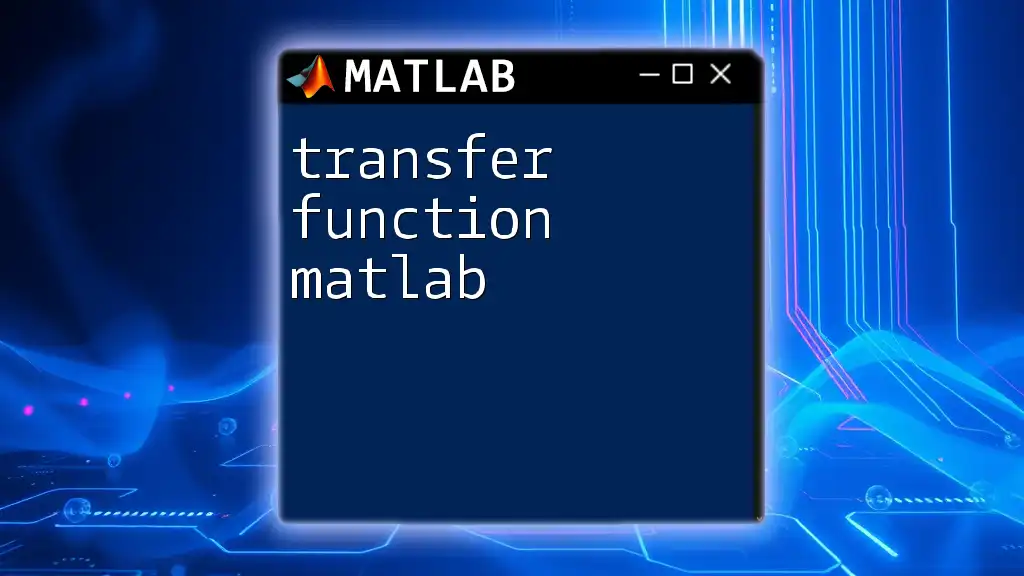In MATLAB, you can easily plot a transfer function using the `tf` and `step` functions to visualize its response, as shown in the following example code snippet:
sys = tf([1], [1, 2, 1]); % Define the transfer function H(s) = 1/(s^2 + 2s + 1)
step(sys); % Plot the step response of the transfer function
Understanding Transfer Function Representation
Definition of Transfer Functions
A transfer function is a mathematical representation of the relationship between the input and output of a linear time-invariant system in the Laplace domain. It can be expressed in the form of:
\[ H(s) = \frac{N(s)}{D(s)} \]
Where N(s) represents the numerator polynomial, and D(s) signifies the denominator polynomial. Each of these polynomials can be defined by their coefficients, which determine the system's dynamics.
Types of Transfer Functions
Transfer functions can be categorized into two main types:
-
Continuous Transfer Functions: These operate based on continuous-time signals, often used in systems controlled by analog methods. An example would be the transfer function of an electronic circuit.
-
Discrete Transfer Functions: These refer to systems that process discrete-time signals, typically utilized in digital controllers. An example would be a sampled data system.

Getting Started with MATLAB for Transfer Functions
Setting Up Your MATLAB Environment
Before diving into plotting, you must ensure your MATLAB environment is ready. This includes verifying that the Control System Toolbox is installed, as it provides many essential functions for working with transfer functions.
To check your installed toolboxes, you can use the following command in MATLAB:
ver
Basic MATLAB Syntax for Transfer Functions
Creating a transfer function in MATLAB is straightforward. You can define the numerator and denominator coefficients using vectors and then create the transfer function model with the `tf` function.
Here's how to do it:
num = [1]; % Numerator coefficients
den = [1, 2, 1]; % Denominator coefficients
sys = tf(num, den); % Creating transfer function
In this example, the transfer function represents a second-order system with the numerator \(1\) and denominator \(s^2 + 2s + 1\).

Plotting Transfer Functions in MATLAB
Generating Bode Plots
A Bode plot is a graphical representation of a transfer function that displays its frequency response. It consists of two plots — one for magnitude and another for phase.
To generate a Bode plot of your transfer function, use the `bode` function:
bode(sys);
grid on; % Adds grid for better visualization
The `grid on` command helps in interpreting the plot more effectively by providing reference lines for magnitude and phase variations.
Step Response and Impulse Response
Understanding how systems respond to inputs is critical in control theory. The main types of responses include step responses and impulse responses.
Plotting Step Responses
The step response of a system shows how it reacts to a sudden change in input. To plot the step response, employ the `step` function:
step(sys);
title('Step Response');
grid on;
This provides insight into the transient and steady-state performance of the system.
Plotting Impulse Responses
An impulse response shows how the system responds to a brief input signal. To visualize this, use the `impulse` function:
impulse(sys);
title('Impulse Response');
grid on;
Analyzing the impulse response helps in understanding the system's natural dynamics and stability characteristics.
Root Locus Plots
The root locus plot illustrates how the roots of a system change with varying feedback gain. This plot is crucial for assessing system stability as you modify gain parameters.
To create a root locus plot in MATLAB, use:
rlocus(sys);
grid on;
The plot provides a visual representation of pole movement as the gain is altered, enabling users to analyze stability margins directly.

Customizing Plots in MATLAB
Adding Labels and Legends
Clear labels and legends are essential for interpreting plots easily. Use descriptive titles and labeled axes to enhance clarity. Here's an example of customizing a Bode plot:
[magnitude, phase, freq] = bode(sys);
title('Customized Bode Plot');
xlabel('Frequency (rad/s)');
ylabel('Magnitude (dB)');
Customizations like this ensure that the readers can understand what each part of the plot conveys.
Changing Plot Styles
You can enhance the visual appeal and clarity of your plots by changing colors and line styles. For example, to change all line colors in your plot to red, you can use:
set(findobj('type','line'),'Color','r'); % Changing line color to red
This command aids in making your plots visually distinctive, which is useful especially when displaying multiple systems' responses.

Common Mistakes and Troubleshooting
When plotting transfer functions in MATLAB, users may encounter common issues:
-
Incorrect Coefficient Definitions: Ensure that the numerator and denominator are correctly defined as vectors.
-
Function Misuse: Each plotting function has specific requirements. Misusing these functions can lead to confusing error messages or unexpected plot outputs.
Troubleshooting Tips
When faced with issues, consider these troubleshooting tips:
-
Check Dimensions: Always make sure your numerator and denominator vectors are of appropriate dimensions corresponding to the order of your transfer function.
-
Consult the Documentation: MATLAB's documentation is robust and can guide you in resolving most issues or clarifying function usage.

Conclusion
In this article, we've explored how to effectively plot transfer functions in MATLAB, from understanding their mathematical representations to visualizing their behavior via Bode plots, step responses, impulse responses, and root locus plots. Engaging in hands-on practice using the examples provided will strengthen your command of these essential tools and techniques.

Additional Resources
For those eager to delve deeper into controlling systems and MATLAB, consider exploring recommended readings, tutorials, and MATLAB’s extensive documentation. Engaging with these resources will enhance your understanding far beyond this starter guide.
Don’t hesitate to reach out with your experiences, questions, or feedback as you continue your journey in mastering MATLAB!

















